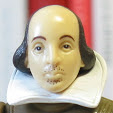 Siegel, Larry. "Fun with Hamlet & his Friends." Humbug 1.7 (February 1958): 27-28, 32.
Siegel, Larry. "Fun with Hamlet & his Friends." Humbug 1.7 (February 1958): 27-28, 32."Laugh, Teacher, Laugh." Time 20 July 1962. 53.
Note: See the update at the end of this post.
Browsing through a Shakespeare dictionary the other day (A Dictionary of Shakespeare by Stanley Wells, to keep the record straight), I was interested to see something the dictionary titled "Teaching Hamlet by the 'look-and-tell' method." That's the method embodied in the 1946 children's book Fun with Dick and Jane. But the dictionary didn't give any context for it other than the reference "from Time-Life (20 July 1962)." I wanted to know more about the history behind this cultural artifact.
With the help of a reference librarian, I managed to track down the specific article (cited above). The article itself says that this anonymous work was passed around during the 1962 National Education Association Convention. The title it gives is Fun with Hamlet and his Friends—and, even more fascinatingly, it says that the section it printed (and which was subsequently included in Wells' dictionary) is merely an excerpt. I wonder if the work in its entirety survives anywhere.
Until it resurfaces, we'll have to be content with the following (and I imagine we can be quite content with this segment alone):
Fun with Hamlet and his Friends
See Hamlet run. Run, Hamlet, Run.
He is going to his mother’s room.
“I have something to tell you, mother,” says Hamlet. “Uncle Claudius is bad. He gave my father poison. Poison is not good. I do not like poison. Do you like poison?”
“Oh, no, indeed!” says his mother. “I do not like poison.”
“Oh, there is Uncle Claudius,” says Hamlet. “He is hiding behind the curtain. Why is he hiding behind the curtain? Shall I stab him? What fun it would be to stab him through the curtain.”
See Hamlet draw his sword. See Hamlet stab. Stab, Hamlet, stab.
See Uncle Claudius’ blood.
See Uncle Claudius’ blood gushing.
Gush, blood, gush.
See Uncle Claudius fall. How funny he looks, stabbed.
Ha, ha, ha.
But it is not Uncle Claudius. It is Polonius. Polonius is Ophelia’s father.
“You are naughty, Hamlet,” says Hamlet’s mother. “You have stabbed Polonius.”
But Hamlet’s mother is not cross. She is a good mother. Hamlet loves his mother very much. Hamlet loves his mother very, very much. Does Hamlet love his mother a little too much? Perhaps.
See Hamlet run. Run, Hamlet, Run.
“I am on my way to find Uncle Claudius,” Hamlet says.
On the way he meets a man. “I am Laertes,” says the man. “Let us draw our swords. Let us duel.”
See Hamlet and Laertes duel. See Laertes stab Hamlet. See Hamlet stab Laertes. See Hamlet’s mother drink poison. See Hamlet stab King Claudius.
See everybody wounded and bleeding and dying and dead.
What fun they are having!
Wouldn’t you like to have fun like that?
Siegel, Larry. "Fun with Hamlet & his Friends." Humbug 1.7 (February 1958): 27-28, 32.
Shortly after this post was published, careful reader Christine pointed us toward a text-only version of the complete work going under the title "The Dick and Jane Hamlet"; much more recently, careful reader Will Linden gave us the name of the author—Larry Siegel, of Mad magazine fame—and the name of the original source—Humbug.
With those clues and the help of the extraordinary reference desk at my library (O, those marvelous librarians—O, that marvelous research), we now have not only the full citation for the original publication (four years earlier than the Time article above) but the full illustrated text from the publication.
Thanks, Will Linden; thanks, Christine; thanks, all careful readers everywhere! And enjoy (click on the images below to enlarge them).












8 comments:
They left out Ophelia!
Finally. A Hamlet I can understand! Go, Bardfilm, go.
Modocmama
I first read this version in my high school British Lit class. We read Shakespeare's as well, but for teen minds it was wonderful to get a laugh in the midst of it. Here is a link to the entire story. At the bottom it says it was written in 1958 for a 1st grade class....but I will admit doubt to that. (But who knows?) Enjoy!
http://users.elite.net/lkfaunt/DJHamlet.html
Noooooo!
This pieces is not "anonymous". It was written by one Larry Siegel for the probably defunct magazine HUMBUG. When the National Observer reprinted it after the NEA distribution, he wrote to tell them that if they did not give him credit, he would sue, sue, sue them, "What fun it will be to sue you!"
Thanks, Will Linden! I'm on the case. I'll report back if I'm able to track it down--particularly if there's an extended version in Humbug.
kj
I checked that book out from the library in Hershey, PA in either 1978 or 79. I don't recall if it was the public library or my school library.
I have looked for the book several times since and never found it.
On a tangentially related topic: my son played Mercutio in "The Seussification of Romeo and Juliet" in 2012 and I had fun sewing costumes.
Thanks, Tania. I'd never heard of The Seussification of Romeo and Juliet, but I'm on the case!
Take care!
kj (Bardfilm)
Post a Comment